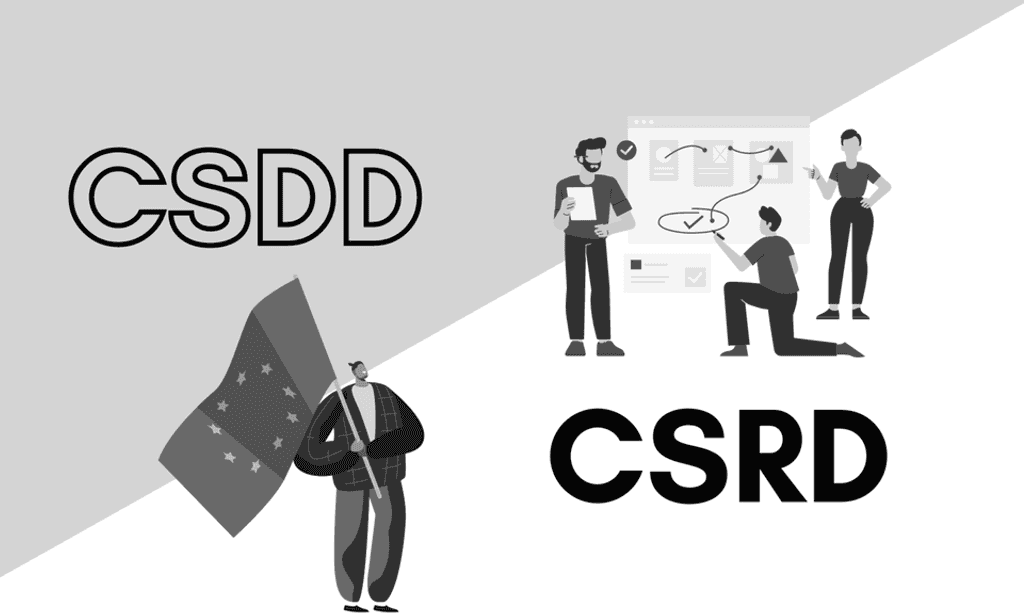A look at the distinctions between the CSDD and CRSD Directives
The adoption of the CSDD Directive in June 2023 adds to the arsenal of European legislative texts that will have a considerable impact on the way companies manage and report on their efforts to respect human rights, environmental impacts and related corporate governance reforms. Although quite distinct from each other, the CSDD and CSRD are nonetheless two pieces of legislation designed to be applied in tandem by companies to kick-start their transition plans. Let's take a closer look at these two directives, which have the potential to shape the future of European businesses and companies interacting with the European market.
CSDD: a reinforced duty of care
The aim of the CSDD directive is to "foster sustainable and responsible corporate behavior and embed human rights and environmental considerations" in companies' activities and governance structures. In other words, it aims to support the EU's transition to a green, climate-neutral economy, as set out in the European Green Deal and in line with the UN's Sustainable Development Goals.
To comply with the duty of care, companies must:
- Integrate the duty of care into their corporate policies
- Define a clear transition plan to prevent or mitigate potential impacts and put an end to actual impacts
- Identify actual or potential negative impacts on human rights and the environment
- Monitoring the effectiveness of vigilance policies and measures
- Communicate publicly on the implementation of these actions
The CSDD will apply to the activities of companies, their subsidiaries and their supply chains. This would particularly concern tech giants, whose harmful environmental and social impact from the manufacture of their IT equipment is already well known. This directive would therefore potentially be a first step towards a stronger commitment by these major companies to Responsible Digital Business and digital decarbonization.
Another new feature that marks a real turning point in terms of CSR: the directive introduces the obligation for companies to set up and oversee the implementation of a precise and rigorous transition plan as part of the company's official strategy. In addition, management is now required to consider the impacts of the company's activities in terms of human rights and environmental impact.
Who is concerned?
The following companies are affected by the directive:
- All EU companies with at least 500 employees and worldwide net sales of at least €150 million
- Companies operating in certain high-impact sectors, such as mining and quarrying, agriculture and textiles, with more than 250 employees and worldwide net sales of €40 million or more.
- Non-European companies with sales in excess of €150 million, provided that at least €40 million of these sales are generated within the EU.
CSRD: a reporting tool that guarantees transparency
Published for the first time in 2021, the CRSD directive rethinks the way companies must disclose information on key sustainability topics. Thanks to this directive, companies must now provide precise and detailed information on their carbon emission reduction plans, demonstrating their commitment to decarbonization. In addition, they must implement due diligence practices to assess and mitigate the environmental and social risks associated with their operations.
In other words, one of the main objectives of the CSRD is to create a common framework for sustainability reporting, with the aim of making companies more transparent and accountable for their environmental and social footprint by improving the way sustainability information is communicated.
One of the cornerstones of CSRD remains "double materiality" analysis: this implies a new approach to the responsibility of companies with regard to their ESG performance, taking into account both their financial relevance and their impact on society and the environment.

Who is concerned?
The CSRD directive as it is written today concerns the following companies:
- Small and medium-sized companies listed on a European market.
- Large unlisted companies that meet the following criteria:
- Total assets in excess of €20 million or net sales in excess of €40 million.
- More than 250 employees.
In addition, non-European companies are also affected if they meet the following conditions:
- They generate sales in excess of 150 million euros in the European Union.
- They have at least one European subsidiary that is listed or meets the definition of a "large company".
- They have at least one European branch generating sales in excess of 40 million euros.
A directive about to be weakened?
Faced with the forthcoming restrictions, however, lobbies have exerted a great deal of pressure. In particular, they have called for a reduction in reporting standards and the removal of certain obligations, including in terms of biodiversity protection. As a result, the Commission is likely to scale back its ambitions with regard to the sustainability indicators defined by Efrag. We'll know in a few months' time what will really happen to the CSRD in its practical application.
Penalties for non-compliance
In the case of CSDD, failure to comply with the directive exposes companies to significant sanctions, which can be applied by national supervisory authorities. These sanctions can take the form of fines of up to 5% of the company's worldwide net sales, and in some cases can lead to a ban on participation in public procurement contracts within the EU. The amount of these fines can vary according to the seriousness of the violation and national regulations.
In the case of CSRD, companies that fail to comply with non-financial reporting requirements may be subject to financial penalties. The amount of these sanctions can be set according to various factors, such as the size of the company and the seriousness of the violation. In addition to financial sanctions, regulatory authorities may take administrative measures against non-compliant companies, such as formal warnings, restrictions on activities or temporary bans.
Transformation levers: the convergences of European directives towards a corporate transition plan
The CSDD and CSRD directives are designed to be implemented in tandem by companies. In a nutshell, the CSDD establishes the due diligence obligations that companies must exercise with regard to human rights and environmental impacts along their supply chains. As for the CSRD directive, it plays a central role as a reporting tool enabling companies to account for their relevant sustainable development initiatives.
Many companies potentially see these directives as too restrictive, difficult to understand and apply, or consider that they don't have the resources to meet them. However, sustainable development departments now have the legal leverage to release funds to implement concrete actions. Meeting the requirements of these directives also enables companies to improve their ESG performance by developing a solid, long-term transition plan. Finally, as Anniina Kristinsson, Managing Director of Nordic Sustainability, pointed out at the Nordic Global Compact 2022 meeting:
"You have the opportunity to use these guidelines as a lever for change, going beyond a simple obligation to fulfill. They offer you the opportunity to put forward new priorities and improve your current strategies for a more sustainable economy." Anniina Kristinsson, Managing Director, Nordic Sustainability
The transition plan made mandatory by these European directives must include a Responsible Digital approach: digital is one of the most significant sources of carbon emissions for a large number of companies, particularly in the tertiary sector. That's why you can take the lead by entrusting your digital decarbonization strategy to a trusted third-party expert in the field, such as fruggr, to measure your impacts and improve them over the long term.
